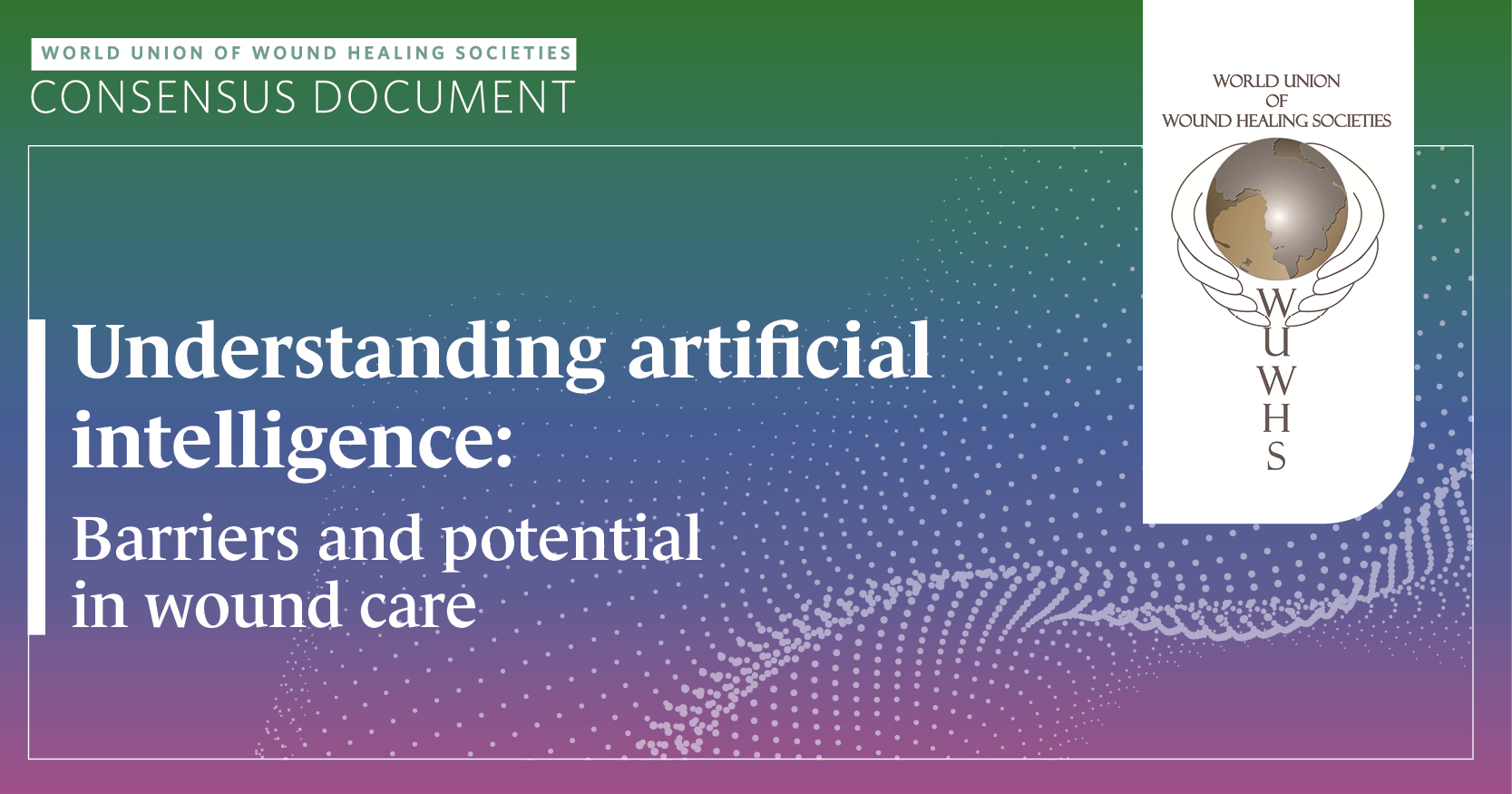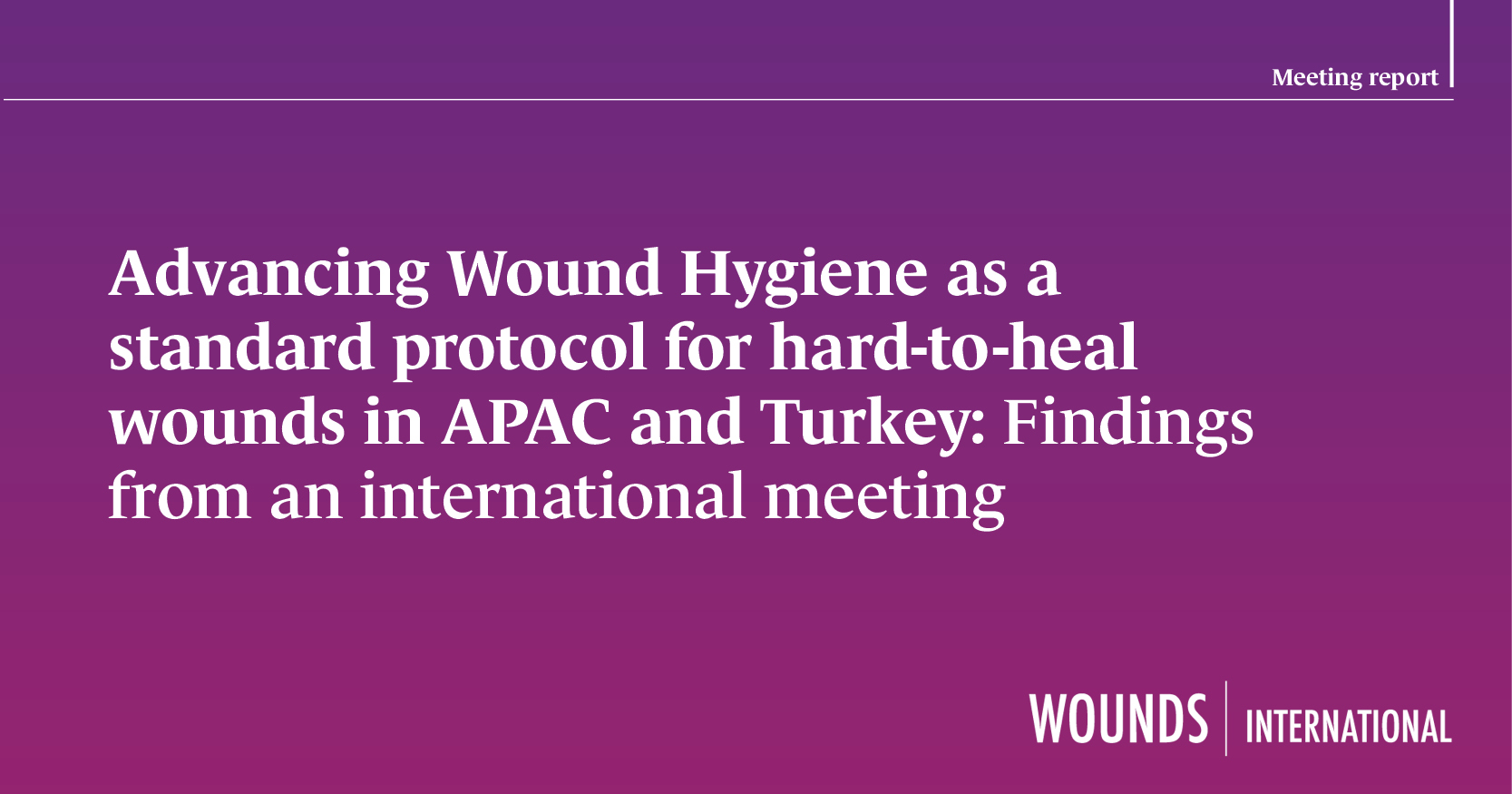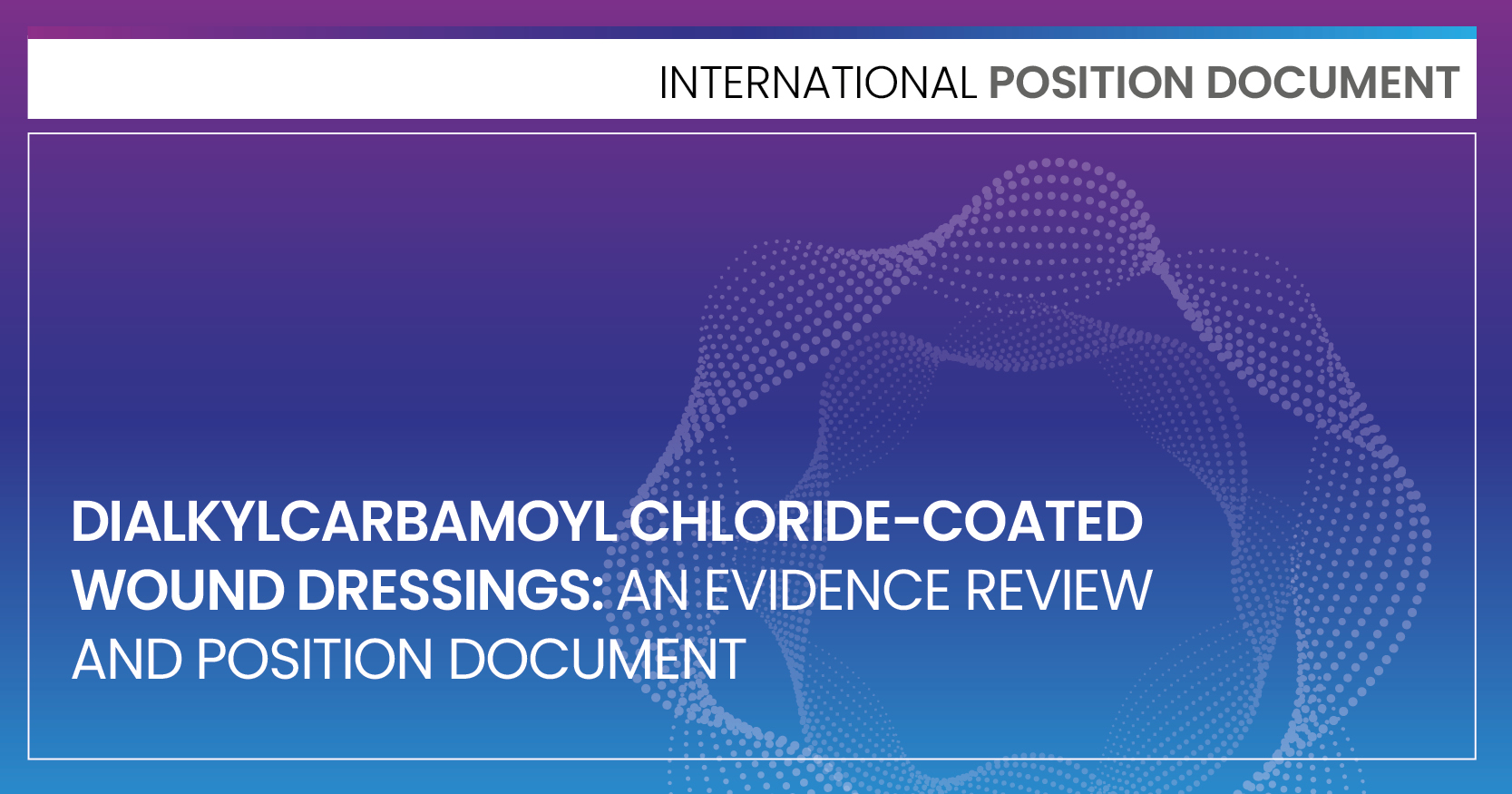ReferencesAhmed MI, Spooner B, Isherwood J et al (2023) A systematic review of the barriers to the implementation of artificial intelligence in healthcare. Cureus 15 (10): e46454
Alowais SA, Alghamdi SS, Alsuhebany N et al (2023) Revolutionizing healthcare: the role of artificial intelligence in clinical practice. BMC Med Edu
23: 689
Anisuzzaman DM, Wang C, Rostami B et al (2022) Image-based artificial intelligence in wound assessment: A systematic review. Adv Wound Care (New Rochelle) 11(12): 687-709
Atkin L, Probst S (2025) Clinical inertia in chronic wound care. Wounds Int 16(1): 48-51
Armstrong DG, Tan TW, Boulton AJM et al (2023) Diabetic Foot Ulcers: A Review. JAMA 330(1): 62-75
Bai X, Zhang H, Jiao Y et al (2024) Digital health interventions for chronic wound management: A systematic review and meta-analysis. J Med Internet Res 26: e47904
Bajwa J, Munir U, Nori A et al (2021) Artificial intelligence in healthcare: transforming the practice of medicine. Future Healthc J 8(2):
e188-94
Balloch J, Sridharan S, Oldham G et al (2024) Use of an ambient artificial intelligence tool to improve quality of clinical documentation. Future Healthc J 11(3): 100157
Bansal N, Vidyarthi A (2024) DFootNet: A Domain Adaptive classification framework for diabetic foot ulcers using dense neural network architecture. Cogn Comput 16: 2511-27
Berk H (2024) Beware of artificial intelligence hallucinations or should we call confabulation? Acta Orthop Traumatol Turc 58(1): 1-3
Breiman L (2001) Statistical modeling: The two cultures (with comments and a rejoinder by the author). Statistical Sci 16(3): 199-231
Chen MY, Cao MQ, Xu TY (2024) Progress in the application of artificial intelligence in skin wound assessment and prediction of healing time. Am J Transl Res 16(7): 2765-76
Chiu TKF, Xia Q, Zhou X et al (2023) Systematic literature review on opportunities, challenges, and future research recommendations of artificial intelligence in education. Comput. Educ Artif Intell 4: 100118
Clough RAJ, Sparkes WA, Clough OT et al (2024) Transforming healthcare documentation: harnessing the potential of AI to generate discharge summaries. BJGP open 8(1): BJGPO.2023.0116
Cullen B, Gefen A (2023) The biological and physiological impact of the performance of wound dressings. Int Wound J 20(4): 1292-303
Cunha Reis T (2025) Artificial intelligence and natural language processing for improved telemedicine: Before, during and after remote consultation. Aten Primaria 57(8): 103228
De Gagne JC (2023) The state of artificial intelligence in nursing education: Past, present, and future directions. Int J Environ Res Public Health 20: 4884
Dynatrace (2024) Understanding black-box ML models with explainable AI. Available at: https://www.dynatrace.com/news/blog/explainable-ai/ (accessed 11.06.2025)
Ecarnação R, Manuel T, Palheira H et al (2024) Artificial intelligence in wound care education: Protocol for a Scoping Review. Nurs Rep 14(1): 627-40
Elhaddad M, Hamam S (2024) AI-driven clinical decision support systems: An ongoing pursuit of potential. Cureus 16(4): e57728
Erdem O, Hassett K, Egriboyun F (2025) Hallucination in AI-generated financial literature reviews: evaluating bibliographic accuracy. Int J Data Sci Analytics 1-10
Esteva A, Kuprel B, Novoa RA et al (2017) Dermatologist-level classification of skin cancer with deep neural networks. Nature 542(7639): 115-8
Feuerriegel S, Hartmann J, Janiesch C et al (2024) Generative AI. Bus Inf Syst Eng 66: 11-26
Fletcher J, Edmonds M, Madden J et al (2024) Demystifying infection in the diabetic foot.
Wounds UK
Frey CB, Osborne MA (2017) The future of employment: How susceptible are jobs to computerisation? Tech Forecast Soc Change 114: 254-80
Faiyazuddin M, Rahman SJQ, Anand G et al (2025) The impact of artificial intelligence on healthcare: A comprehensive review of advancements in diagnostics, treatment, and operational efficiency. Health Sci Rep 8(1): e70312
Ganesan O, Morris MX, Guo L et al (2024) A review of artificial intelligence in wound care. Art Int Surg 4: 364-75
Gould L, Herman I (2025) Out of the Darkness and Into the Light: Confronting the global challenges in wound education. Int Wound J 22(1): e70178. Erratum in: Int Wound J (2025); 22(2): e70195
Hirani R, Noruzi K, Khuram H et al (2024) Artificial intelligence and healthcare: A journey through history, present innovations, and future possibilities. Life 14: 557
International Business Machines Corporation (2021) Computer vision. Available at: https://www.ibm.com/think/topics/computer-vision (accessed 17.09.2025)
International Business Machines Corporation (2024a) What is black box AI? Available at: https://www.ibm.com/think/topics/black-box-ai#:~:text=Even%20open%2Dsource%20AI%20models,happens%20within%20each%20layer%20of (accessed 13.06.2025)
International Business Machines Corporation (2024b) Generative AI. Available at: https://research.ibm.com/blog/what-is-generative-AI (accessed 13.06.2025)
Jiang F, Jiang Y, Zhi H et al (2017) Artificial intelligence in healthcare: past, present and future. Stroke Vas Neurol 2: 4
Kabir MA, Samad S, Ahmed F et al (2024) Mobile apps for wound assessment and monitoring: Limitations, advancements and opportunities. J Med Syst 48(1): 80
Katsoulakis E, Wang Q, Wu H et al (2024) Digital twins for health: a scoping review. NPJ Digit Med 7(1): 77
Kaul V, Enslin S, Gross SA (2020) History of artificial intelligence in medicine. Gastrointest Endosc 92(4): 807-12
Khalid N, Qayyum A, Bilal M et al (2023) Privacy-preserving artificial intelligence in healthcare: Techniques and applications. Comput Biol Med 158: 106848
Krishnamoorthy CS, Rajeev S, eds (1996) Artificial intelligence and expert systems for engineers Vol 1. CRC Press, Boca Raton: 59
Krishnan A, Anahtar M N, Valeri JA et al (2025)
A generative deep learning approach to de novo antibiotic design. Cell S0092-8674(25): 00855-4
Le DTP and Pham TD (2023) Unveiling the role of artificial intelligence for wound assessment and wound healing prediction. Explor Med 4: 589-611
Lee TC, Shah NU, Haack A et al (2020) Clinical implementation of predictive models embedded within electronic health record systems: A systematic review. Informatics 7(3): 25
Lee D, Arnold M, Srivastava A et al (2024) The impact of generative AI on higher education learning and teaching: A study of educators’ perspectives. Comput Edu Art Intel 6(2024): 100221
Liu H, Sun W, Cai W et al (2025) Current status, challenges, and prospects of artificial intelligence applications in wound repair theranostics. Theranostics 15(5): 1662-88
Medicines & Healthcare products Regulatory Agency (2025) Guidance. Software and artificial intelligence (AI) as a medical device. Available at: https://www.gov.uk/government/publications/software-and-artificial-intelligence-ai-as-a-medical-device/software-and-artificial-intelligence-ai-as-a-medical-device (accessed 30.07.2025)
Mitchell TM (1997) Does machine learning really work? AI Mag 18(3): 11-20
Muhiyaddin R, Elfadl A, Mohamed E et al (2022) Electronic health records and physician burnout: a scoping review. Stud Health Technol Inform 289: 481–4
Naqvi M, Gilani SQ, Syed T et al (2023) Skin cancer detection using deep learning – a review. Diagnostics (Basel) 13(11): 1911
National Health Service (2024) ‘World first’ as Newcastle uses AI to predict how burns will heal. Available at: https://www.newcastle-hospitals.nhs.uk/news/world-first-as-newcastle-uses-ai-to-predict-how-burns-will-heal/ (accessed 04.02.2025)
National Library of Medicine (2024) Reinforcement machine learning. Available at: https://www.ncbi.nlm.nih.gov/mesh/?term=Reinforcement+Learning (accessed 17.09.2025)
Nembhard IM, David G, Ezzeddine I et al (2023) A systematic review of research on empathy in health care. Health Ser Res 58(2): 250-63
Preiksaitis C, Rose C (2023) Opportunities, challenges, and future directions of generative artificial intelligence in medical education: Scoping review. JMIR Med Edu 9: e48785
Probst S, Menon T, Stefanelli A et al (2025) Empathy in wound care: A scoping review of its role, impact, and barriers to person-centred healing. Int Wound J 22(6): e70687
Queen D, Harding K (2019) Data-driven specialisation of wound care through artificial intelligence. Int Wound J 16(4): 879-80
Reifs JD, Casanova-lozano L, Reig-bolaño R et al (2023) Clinical validation of computer vision and artificial intelligence algorithms for wound measurement and tissue classification in wound care. Informatics Med Unlock 37: 101185
Reifs JD, Casanova-Lozano L, Grau-Carrión S et al (2025) Artificial Intelligence methods for diagnostic and decision-making assistance in chronic wounds: A systematic review. J Med Syst 49(1): 29
Rippon MG, Fleming L, Chen T et al (2024) Artificial intelligence in wound care: diagnosis, assessment and treatment of hard-to-heal wounds: a narrative review. J Wound Care 33(4): 229-42
Rochon M, Tanner J, Jurkiewicz J et al (2024) Wound imaging software and digital platform to assist review of surgical wounds using patient smartphones: The development and evaluation of artificial intelligence (WISDOM AI study). PLoS One 19(12): e0315384
Rudroff T (2024) Artificial intelligence as a replacement for animal experiments in neurology: potential, progress and challenges. Neurol Int 16 (4): 805-20
Schakel L, Veldhuijzen S, Crompvoets PI, et al (2019) Effectiveness of stress-reducing interventions on the response to challenges to the immune system: A meta-analytic review. Psychother Psychosom 88(5): 274-86
Sen CK (2021) Human wound and its burden: Updated 2020 compendium of estimates. Adv Wound Care (New Rochelle) 10(5): 281-92
Shickel B, Tighe PJ, Bihorac A et al (2018) Deep EHR: A survey of recent advances in deep learning techniques for electronic health record (EHR) analysis. IEEE J Biomed Health Inform 22: 1589-604
Shimron E, Perlman O (2023) AI in MRI: Computational frameworks for a faster, optimized, and automated imaging workflow. Bioengineering (Basel) 10(4): 492
Stefanelli A, Zahia S, Chanel G et al (2025) Developing an AI-powered wound assessment tool: a methodological approach to data collection and model optimization. BMC Med Inform Decis Mak 25(1): 297
Stryker C, Kavalakoglu S (2024) What is Artificial Intelligence (AI)? Available at: https://www.ibm.com/think/topics/artificial-intelligence (accessed 10.06.2025)
Tanno R, Barrett DGT, Sellergren A et al (2025) Collaboration between clinicians and vision–language models in radiology report generation. Nat Med 31: 599-608
The King’s Fund (2018) The health care workforce in England: make or break? Available at: https://www.kingsfund.org.uk/insight-and-analysis/reports/health-care-workforce-england (accessed 11.06.2025)
Tikhomirov L, Semmler C, McCradden M et al (2024) Medical artificial intelligence for clinicians: the lost cognitive perspective. Lancet Dig Health 6(8): e589-94
Webster CS, Taylor S, Thomas C et al (2022) Social bias, discrimination and inequity in healthcare: mechanisms, implications and recommendations. BJA Edu 22(4): 131-7
West Yorkshire Association of Acute Trusts (2025) Yorkshire Imaging Collaborative leading the national roll out of new AI solution to support lung cancer diagnoses. Available at: https://wyaat.wyhpartnership.co.uk/news/yorkshire-imaging-collaborative-leading-national-roll-out-new-ai-solution-diagnose-lung-cancer-quicker (accessed 11.08.2025)
Wongvibulsin S, Yan MJ, Pahalyants V et al (2024) Current state of dermatology mobile applications with artificial intelligence features. JAMA Dermatol 160(6): 646-50
World Health Organization (2016) Working for health and growth: Investing in the health workforce. Available at: http://apps.who. int/iris/bitstream/10665/250047/1/9789241511308-eng.pdf (accessed 10.06.2025)
World Union of Wound Healing Societies (2025) Implementing Wound Balance: Outcomes and future recommendations. London: Wounds International. Available at: www.woundsinternational.com
Yu H, Guo Y (2023) Generative artificial intelligence empowers educational reform: Current status, issues, and prospects. Front Edu 8: 1183162
Zaretsky J, Kim JM, Baskharoun S (2024) Generative artificial intelligence to transform inpatient discharge summaries to patient-friendly language and format. JAMA Netw Open 7(3): e240357





